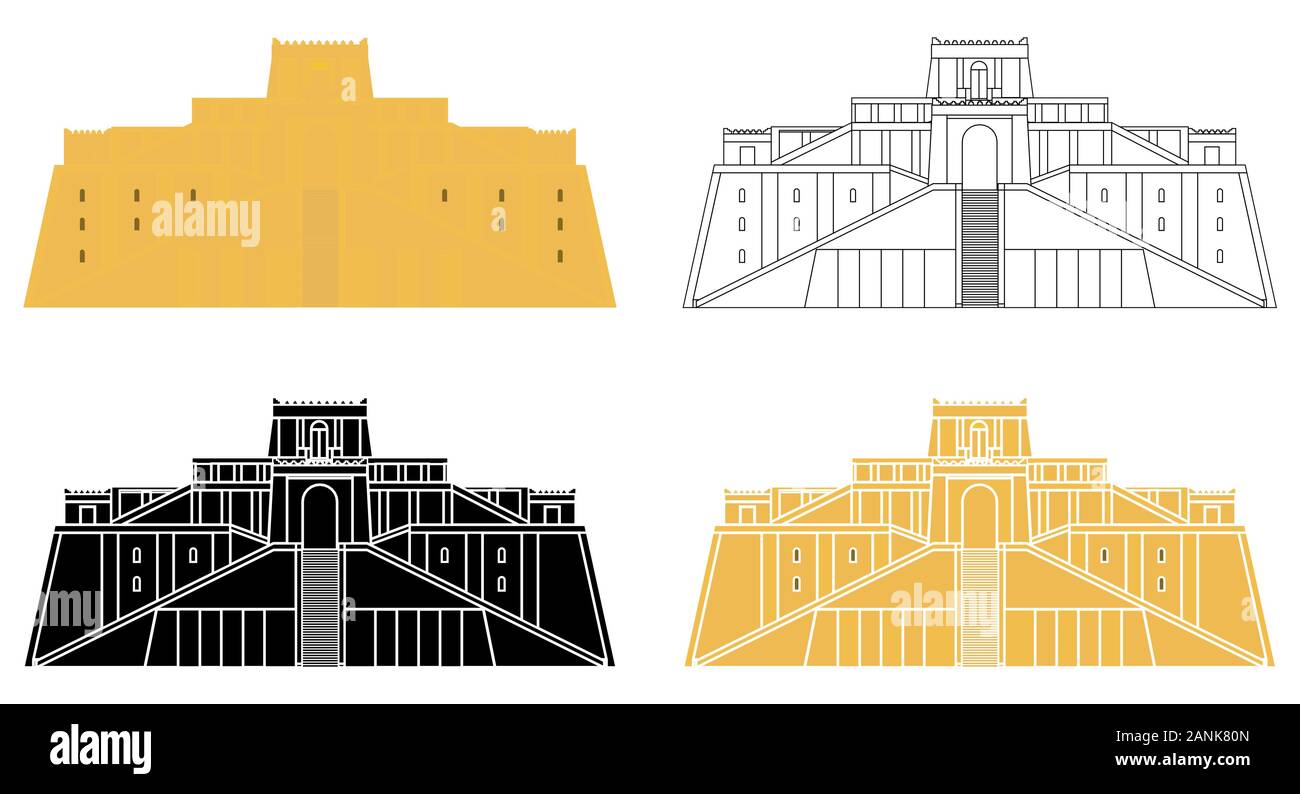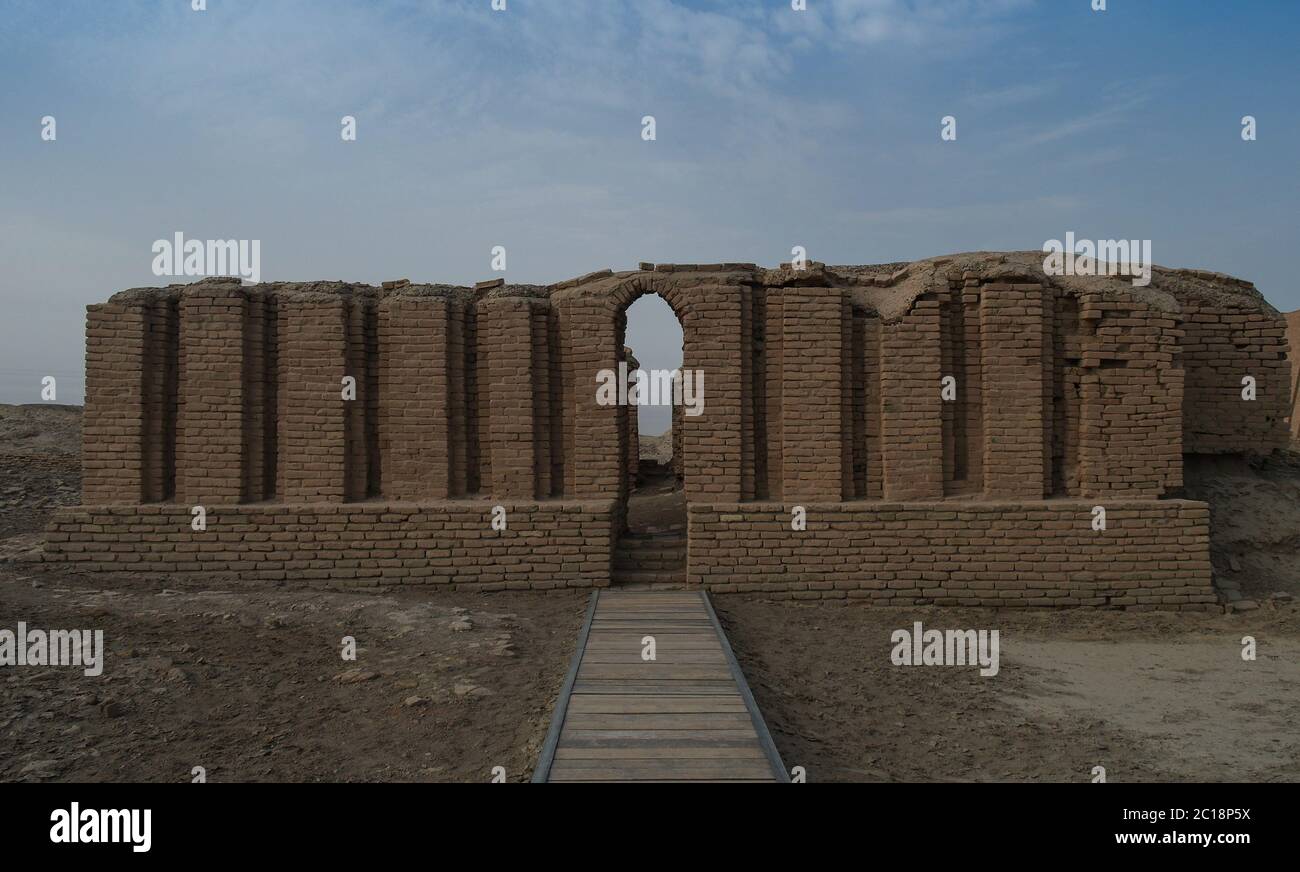Quick filters:
Sumerian ruins ur palace Stock Photos and Images
 The great Ziggurat at Ur in front view Stock Vectorhttps://www.alamy.com/image-license-details/?v=1https://www.alamy.com/the-great-ziggurat-at-ur-in-front-view-image340328149.html
The great Ziggurat at Ur in front view Stock Vectorhttps://www.alamy.com/image-license-details/?v=1https://www.alamy.com/the-great-ziggurat-at-ur-in-front-view-image340328149.htmlRF2ANK80N–The great Ziggurat at Ur in front view
 A Palace and Temple 4000 Years ago and the ruins today .Part of the actual ruins of the Palace of the Princes of Eshnunna at Tell Asmar , the first Palace of the period ( about 2200 BC ) ever excavated : The main entrance of the Palace central in the drawings with its lofty entrance doorway . 1 October 1932 Stock Photohttps://www.alamy.com/image-license-details/?v=1https://www.alamy.com/a-palace-and-temple-4000-years-ago-and-the-ruins-today-part-of-the-actual-ruins-of-the-palace-of-the-princes-of-eshnunna-at-tell-asmar-the-first-palace-of-the-period-about-2200-bc-ever-excavated-the-main-entrance-of-the-palace-central-in-the-drawings-with-its-lofty-entrance-doorway-1-october-1932-image623920962.html
A Palace and Temple 4000 Years ago and the ruins today .Part of the actual ruins of the Palace of the Princes of Eshnunna at Tell Asmar , the first Palace of the period ( about 2200 BC ) ever excavated : The main entrance of the Palace central in the drawings with its lofty entrance doorway . 1 October 1932 Stock Photohttps://www.alamy.com/image-license-details/?v=1https://www.alamy.com/a-palace-and-temple-4000-years-ago-and-the-ruins-today-part-of-the-actual-ruins-of-the-palace-of-the-princes-of-eshnunna-at-tell-asmar-the-first-palace-of-the-period-about-2200-bc-ever-excavated-the-main-entrance-of-the-palace-central-in-the-drawings-with-its-lofty-entrance-doorway-1-october-1932-image623920962.htmlRM2Y721FE–A Palace and Temple 4000 Years ago and the ruins today .Part of the actual ruins of the Palace of the Princes of Eshnunna at Tell Asmar , the first Palace of the period ( about 2200 BC ) ever excavated : The main entrance of the Palace central in the drawings with its lofty entrance doorway . 1 October 1932
 ruined wall of king palace in Ur, Dhi Qar, Iraq Stock Photohttps://www.alamy.com/image-license-details/?v=1https://www.alamy.com/ruined-wall-of-king-palace-in-ur-dhi-qar-iraq-image237464962.html
ruined wall of king palace in Ur, Dhi Qar, Iraq Stock Photohttps://www.alamy.com/image-license-details/?v=1https://www.alamy.com/ruined-wall-of-king-palace-in-ur-dhi-qar-iraq-image237464962.htmlRFRP9CYE–ruined wall of king palace in Ur, Dhi Qar, Iraq
 Oldest in the world ancient arch, Ur, Dhi Qar, Iraq Stock Photohttps://www.alamy.com/image-license-details/?v=1https://www.alamy.com/oldest-in-the-world-ancient-arch-ur-dhi-qar-iraq-image362225414.html
Oldest in the world ancient arch, Ur, Dhi Qar, Iraq Stock Photohttps://www.alamy.com/image-license-details/?v=1https://www.alamy.com/oldest-in-the-world-ancient-arch-ur-dhi-qar-iraq-image362225414.htmlRM2C18P5X–Oldest in the world ancient arch, Ur, Dhi Qar, Iraq
 . I'IG. 2.—E-XCAVATING THK TEMPI.E: OF THE JIOOX-GOD AT UR IX 1919. The ziggurat, or temple-tower, in background. By courtesy of the British Museum. the staged tower already mentioned above which was the outstanding feature of all Sumerian towns, its bulk dwarfing all the other buildings of the place and dominating the flat alluvial plain around ; even to- day its ruins are a landmark visible for many miles. In the south corner there may have been the palace of the king, a site which perhaps still awaits excava- tion ; the rest of the temenos, so far as we can yet judge, was occupied by temple Stock Photohttps://www.alamy.com/image-license-details/?v=1https://www.alamy.com/iig-2e-xcavating-thk-tempie-of-the-jioox-god-at-ur-ix-1919-the-ziggurat-or-temple-tower-in-background-by-courtesy-of-the-british-museum-the-staged-tower-already-mentioned-above-which-was-the-outstanding-feature-of-all-sumerian-towns-its-bulk-dwarfing-all-the-other-buildings-of-the-place-and-dominating-the-flat-alluvial-plain-around-even-to-day-its-ruins-are-a-landmark-visible-for-many-miles-in-the-south-corner-there-may-have-been-the-palace-of-the-king-a-site-which-perhaps-still-awaits-excava-tion-the-rest-of-the-temenos-so-far-as-we-can-yet-judge-was-occupied-by-temple-image180027260.html
. I'IG. 2.—E-XCAVATING THK TEMPI.E: OF THE JIOOX-GOD AT UR IX 1919. The ziggurat, or temple-tower, in background. By courtesy of the British Museum. the staged tower already mentioned above which was the outstanding feature of all Sumerian towns, its bulk dwarfing all the other buildings of the place and dominating the flat alluvial plain around ; even to- day its ruins are a landmark visible for many miles. In the south corner there may have been the palace of the king, a site which perhaps still awaits excava- tion ; the rest of the temenos, so far as we can yet judge, was occupied by temple Stock Photohttps://www.alamy.com/image-license-details/?v=1https://www.alamy.com/iig-2e-xcavating-thk-tempie-of-the-jioox-god-at-ur-ix-1919-the-ziggurat-or-temple-tower-in-background-by-courtesy-of-the-british-museum-the-staged-tower-already-mentioned-above-which-was-the-outstanding-feature-of-all-sumerian-towns-its-bulk-dwarfing-all-the-other-buildings-of-the-place-and-dominating-the-flat-alluvial-plain-around-even-to-day-its-ruins-are-a-landmark-visible-for-many-miles-in-the-south-corner-there-may-have-been-the-palace-of-the-king-a-site-which-perhaps-still-awaits-excava-tion-the-rest-of-the-temenos-so-far-as-we-can-yet-judge-was-occupied-by-temple-image180027260.htmlRMMCTXH0–. I'IG. 2.—E-XCAVATING THK TEMPI.E: OF THE JIOOX-GOD AT UR IX 1919. The ziggurat, or temple-tower, in background. By courtesy of the British Museum. the staged tower already mentioned above which was the outstanding feature of all Sumerian towns, its bulk dwarfing all the other buildings of the place and dominating the flat alluvial plain around ; even to- day its ruins are a landmark visible for many miles. In the south corner there may have been the palace of the king, a site which perhaps still awaits excava- tion ; the rest of the temenos, so far as we can yet judge, was occupied by temple
 The great Ziggurat at Ur in perspective view Stock Vectorhttps://www.alamy.com/image-license-details/?v=1https://www.alamy.com/the-great-ziggurat-at-ur-in-perspective-view-image340328157.html
The great Ziggurat at Ur in perspective view Stock Vectorhttps://www.alamy.com/image-license-details/?v=1https://www.alamy.com/the-great-ziggurat-at-ur-in-perspective-view-image340328157.htmlRF2ANK811–The great Ziggurat at Ur in perspective view
 A Palace and Temple 4000 Years ago and the ruins today .Part of the actual ruins of the Temple of Gimilsin at Eshnunna (now Tell Asmar ) , the first Palace of the period ( about 2200 BC ) ever excavated : Seen here the courtyard , right the entrance passage , left sanctuary , foreground later walls , centre background wall , with part of the well showing above 1 October 1932 Stock Photohttps://www.alamy.com/image-license-details/?v=1https://www.alamy.com/a-palace-and-temple-4000-years-ago-and-the-ruins-today-part-of-the-actual-ruins-of-the-temple-of-gimilsin-at-eshnunna-now-tell-asmar-the-first-palace-of-the-period-about-2200-bc-ever-excavated-seen-here-the-courtyard-right-the-entrance-passage-left-sanctuary-foreground-later-walls-centre-background-wall-with-part-of-the-well-showing-above-1-october-1932-image623920946.html
A Palace and Temple 4000 Years ago and the ruins today .Part of the actual ruins of the Temple of Gimilsin at Eshnunna (now Tell Asmar ) , the first Palace of the period ( about 2200 BC ) ever excavated : Seen here the courtyard , right the entrance passage , left sanctuary , foreground later walls , centre background wall , with part of the well showing above 1 October 1932 Stock Photohttps://www.alamy.com/image-license-details/?v=1https://www.alamy.com/a-palace-and-temple-4000-years-ago-and-the-ruins-today-part-of-the-actual-ruins-of-the-temple-of-gimilsin-at-eshnunna-now-tell-asmar-the-first-palace-of-the-period-about-2200-bc-ever-excavated-seen-here-the-courtyard-right-the-entrance-passage-left-sanctuary-foreground-later-walls-centre-background-wall-with-part-of-the-well-showing-above-1-october-1932-image623920946.htmlRM2Y721EX–A Palace and Temple 4000 Years ago and the ruins today .Part of the actual ruins of the Temple of Gimilsin at Eshnunna (now Tell Asmar ) , the first Palace of the period ( about 2200 BC ) ever excavated : Seen here the courtyard , right the entrance passage , left sanctuary , foreground later walls , centre background wall , with part of the well showing above 1 October 1932
 Oldest in the world ancient arch part of king palace, Ur, Dhi Qar, Iraq Stock Photohttps://www.alamy.com/image-license-details/?v=1https://www.alamy.com/oldest-in-the-world-ancient-arch-part-of-king-palace-ur-dhi-qar-iraq-image183209362.html
Oldest in the world ancient arch part of king palace, Ur, Dhi Qar, Iraq Stock Photohttps://www.alamy.com/image-license-details/?v=1https://www.alamy.com/oldest-in-the-world-ancient-arch-part-of-king-palace-ur-dhi-qar-iraq-image183209362.htmlRFMJ1WBE–Oldest in the world ancient arch part of king palace, Ur, Dhi Qar, Iraq
 A Palace and Temple 4000 Years ago and the ruins today .Part of the actual ruins of the Temple of Gimilsin at Eshnunna (now Tell Asmar ) , the first Palace of the period ( about 2200 BC ) ever excavated : Seen here traces of ancient ritual found for the first time , pottery drains for libations , or the blood and water of sacrifices , in the ruins of the state temple at Eshnunna , found beneath the mud floor . 1 October 1932 Stock Photohttps://www.alamy.com/image-license-details/?v=1https://www.alamy.com/a-palace-and-temple-4000-years-ago-and-the-ruins-today-part-of-the-actual-ruins-of-the-temple-of-gimilsin-at-eshnunna-now-tell-asmar-the-first-palace-of-the-period-about-2200-bc-ever-excavated-seen-here-traces-of-ancient-ritual-found-for-the-first-time-pottery-drains-for-libations-or-the-blood-and-water-of-sacrifices-in-the-ruins-of-the-state-temple-at-eshnunna-found-beneath-the-mud-floor-1-october-1932-image623920961.html
A Palace and Temple 4000 Years ago and the ruins today .Part of the actual ruins of the Temple of Gimilsin at Eshnunna (now Tell Asmar ) , the first Palace of the period ( about 2200 BC ) ever excavated : Seen here traces of ancient ritual found for the first time , pottery drains for libations , or the blood and water of sacrifices , in the ruins of the state temple at Eshnunna , found beneath the mud floor . 1 October 1932 Stock Photohttps://www.alamy.com/image-license-details/?v=1https://www.alamy.com/a-palace-and-temple-4000-years-ago-and-the-ruins-today-part-of-the-actual-ruins-of-the-temple-of-gimilsin-at-eshnunna-now-tell-asmar-the-first-palace-of-the-period-about-2200-bc-ever-excavated-seen-here-traces-of-ancient-ritual-found-for-the-first-time-pottery-drains-for-libations-or-the-blood-and-water-of-sacrifices-in-the-ruins-of-the-state-temple-at-eshnunna-found-beneath-the-mud-floor-1-october-1932-image623920961.htmlRM2Y721FD–A Palace and Temple 4000 Years ago and the ruins today .Part of the actual ruins of the Temple of Gimilsin at Eshnunna (now Tell Asmar ) , the first Palace of the period ( about 2200 BC ) ever excavated : Seen here traces of ancient ritual found for the first time , pottery drains for libations , or the blood and water of sacrifices , in the ruins of the state temple at Eshnunna , found beneath the mud floor . 1 October 1932
 Inside of Abrahams House in Ur at Dhi Qar, Iraq Stock Photohttps://www.alamy.com/image-license-details/?v=1https://www.alamy.com/inside-of-abrahams-house-in-ur-at-dhi-qar-iraq-image239001574.html
Inside of Abrahams House in Ur at Dhi Qar, Iraq Stock Photohttps://www.alamy.com/image-license-details/?v=1https://www.alamy.com/inside-of-abrahams-house-in-ur-at-dhi-qar-iraq-image239001574.htmlRFRTRCXE–Inside of Abrahams House in Ur at Dhi Qar, Iraq
 A Palace and Temple 4000 Years ago and the ruins today .Part of the actual ruins of the Temple of Gimilsin at Eshnunna (now Tell Asmar ) , the first Palace of the period ( about 2200 BC ) ever excavated : Seen here the history of the Eshnunna Palace as registered by a succession in floor levels , some containing inscribed baked bricks , a chronological strata in the excavations at Tell Asmar 1 October 1932 Stock Photohttps://www.alamy.com/image-license-details/?v=1https://www.alamy.com/a-palace-and-temple-4000-years-ago-and-the-ruins-today-part-of-the-actual-ruins-of-the-temple-of-gimilsin-at-eshnunna-now-tell-asmar-the-first-palace-of-the-period-about-2200-bc-ever-excavated-seen-here-the-history-of-the-eshnunna-palace-as-registered-by-a-succession-in-floor-levels-some-containing-inscribed-baked-bricks-a-chronological-strata-in-the-excavations-at-tell-asmar-1-october-1932-image623920937.html
A Palace and Temple 4000 Years ago and the ruins today .Part of the actual ruins of the Temple of Gimilsin at Eshnunna (now Tell Asmar ) , the first Palace of the period ( about 2200 BC ) ever excavated : Seen here the history of the Eshnunna Palace as registered by a succession in floor levels , some containing inscribed baked bricks , a chronological strata in the excavations at Tell Asmar 1 October 1932 Stock Photohttps://www.alamy.com/image-license-details/?v=1https://www.alamy.com/a-palace-and-temple-4000-years-ago-and-the-ruins-today-part-of-the-actual-ruins-of-the-temple-of-gimilsin-at-eshnunna-now-tell-asmar-the-first-palace-of-the-period-about-2200-bc-ever-excavated-seen-here-the-history-of-the-eshnunna-palace-as-registered-by-a-succession-in-floor-levels-some-containing-inscribed-baked-bricks-a-chronological-strata-in-the-excavations-at-tell-asmar-1-october-1932-image623920937.htmlRM2Y721EH–A Palace and Temple 4000 Years ago and the ruins today .Part of the actual ruins of the Temple of Gimilsin at Eshnunna (now Tell Asmar ) , the first Palace of the period ( about 2200 BC ) ever excavated : Seen here the history of the Eshnunna Palace as registered by a succession in floor levels , some containing inscribed baked bricks , a chronological strata in the excavations at Tell Asmar 1 October 1932
 A Palace and Temple 4000 Years ago and the ruins today .Part of the actual ruins of the Temple of Gimilsin at Eshnunna (now Tell Asmar ) , the first Palace of the period ( about 2200 BC ) ever excavated : Seen here a curiously constructed well in the Palace at Eshnunna . A vaulted effect produced by sloping courses of square bricks , the first course being tilted by a support of brick fragments . 1 October 1932 Stock Photohttps://www.alamy.com/image-license-details/?v=1https://www.alamy.com/a-palace-and-temple-4000-years-ago-and-the-ruins-today-part-of-the-actual-ruins-of-the-temple-of-gimilsin-at-eshnunna-now-tell-asmar-the-first-palace-of-the-period-about-2200-bc-ever-excavated-seen-here-a-curiously-constructed-well-in-the-palace-at-eshnunna-a-vaulted-effect-produced-by-sloping-courses-of-square-bricks-the-first-course-being-tilted-by-a-support-of-brick-fragments-1-october-1932-image623920941.html
A Palace and Temple 4000 Years ago and the ruins today .Part of the actual ruins of the Temple of Gimilsin at Eshnunna (now Tell Asmar ) , the first Palace of the period ( about 2200 BC ) ever excavated : Seen here a curiously constructed well in the Palace at Eshnunna . A vaulted effect produced by sloping courses of square bricks , the first course being tilted by a support of brick fragments . 1 October 1932 Stock Photohttps://www.alamy.com/image-license-details/?v=1https://www.alamy.com/a-palace-and-temple-4000-years-ago-and-the-ruins-today-part-of-the-actual-ruins-of-the-temple-of-gimilsin-at-eshnunna-now-tell-asmar-the-first-palace-of-the-period-about-2200-bc-ever-excavated-seen-here-a-curiously-constructed-well-in-the-palace-at-eshnunna-a-vaulted-effect-produced-by-sloping-courses-of-square-bricks-the-first-course-being-tilted-by-a-support-of-brick-fragments-1-october-1932-image623920941.htmlRM2Y721EN–A Palace and Temple 4000 Years ago and the ruins today .Part of the actual ruins of the Temple of Gimilsin at Eshnunna (now Tell Asmar ) , the first Palace of the period ( about 2200 BC ) ever excavated : Seen here a curiously constructed well in the Palace at Eshnunna . A vaulted effect produced by sloping courses of square bricks , the first course being tilted by a support of brick fragments . 1 October 1932
 A Palace and Temple 4000 Years ago and the ruins today .Part of the actual ruins of the Temple of Gimilsin at Eshnunna (now Tell Asmar ) , the first Palace of the period ( about 2200 BC ) ever excavated : Seen here important historical evidence with one of the granite pivot stones , or hinge stones , inscribed with the name of the Royal Temple Builder ( Ituria ) , being discussed by Mr Seton Lloyd (left) and Dr Jacobsen . 1 October 1932 Stock Photohttps://www.alamy.com/image-license-details/?v=1https://www.alamy.com/a-palace-and-temple-4000-years-ago-and-the-ruins-today-part-of-the-actual-ruins-of-the-temple-of-gimilsin-at-eshnunna-now-tell-asmar-the-first-palace-of-the-period-about-2200-bc-ever-excavated-seen-here-important-historical-evidence-with-one-of-the-granite-pivot-stones-or-hinge-stones-inscribed-with-the-name-of-the-royal-temple-builder-ituria-being-discussed-by-mr-seton-lloyd-left-and-dr-jacobsen-1-october-1932-image623920935.html
A Palace and Temple 4000 Years ago and the ruins today .Part of the actual ruins of the Temple of Gimilsin at Eshnunna (now Tell Asmar ) , the first Palace of the period ( about 2200 BC ) ever excavated : Seen here important historical evidence with one of the granite pivot stones , or hinge stones , inscribed with the name of the Royal Temple Builder ( Ituria ) , being discussed by Mr Seton Lloyd (left) and Dr Jacobsen . 1 October 1932 Stock Photohttps://www.alamy.com/image-license-details/?v=1https://www.alamy.com/a-palace-and-temple-4000-years-ago-and-the-ruins-today-part-of-the-actual-ruins-of-the-temple-of-gimilsin-at-eshnunna-now-tell-asmar-the-first-palace-of-the-period-about-2200-bc-ever-excavated-seen-here-important-historical-evidence-with-one-of-the-granite-pivot-stones-or-hinge-stones-inscribed-with-the-name-of-the-royal-temple-builder-ituria-being-discussed-by-mr-seton-lloyd-left-and-dr-jacobsen-1-october-1932-image623920935.htmlRM2Y721EF–A Palace and Temple 4000 Years ago and the ruins today .Part of the actual ruins of the Temple of Gimilsin at Eshnunna (now Tell Asmar ) , the first Palace of the period ( about 2200 BC ) ever excavated : Seen here important historical evidence with one of the granite pivot stones , or hinge stones , inscribed with the name of the Royal Temple Builder ( Ituria ) , being discussed by Mr Seton Lloyd (left) and Dr Jacobsen . 1 October 1932